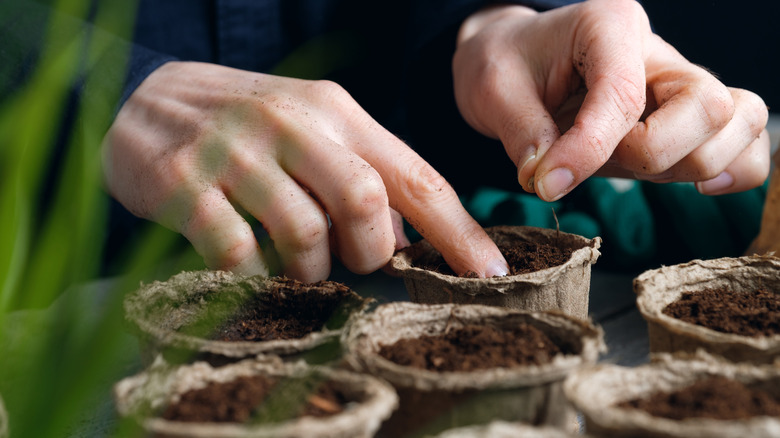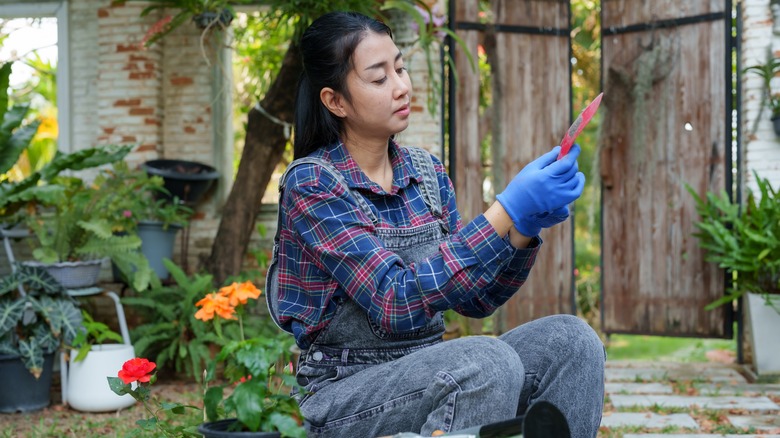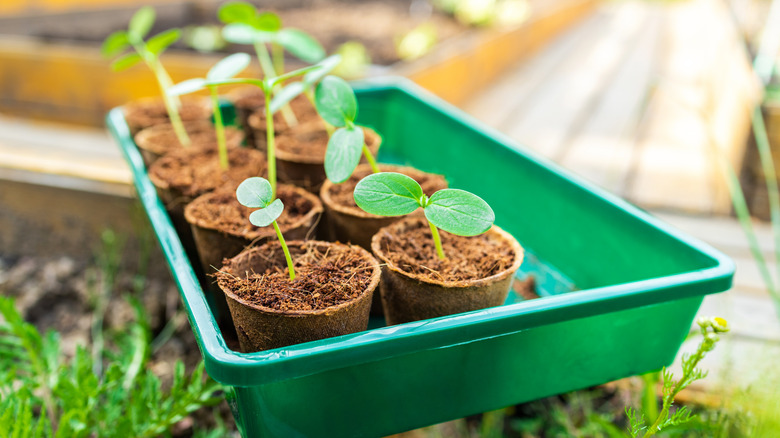Should You Start Seeds Indoors Or Direct Sow When Growing Flowers? It Depends
If you're a gardener, you know that there are few sounds more pleasing to the ear than the rattle of newly purchased seed packets. Seeding time means that spring and summer are just on the horizon, but if you're eager to start your newest flower friends and enjoy healthy spring blooms, it's important to go about it the right way. In an exclusive interview with House Digest, flower farmer and professional gardener, Sam Arthurs, shared some helpful advice on whether you should start your seeds indoors or outdoors. According to Arthurs, there's no definitive right or wrong answer. "The choice varies based both on external factors and types of flowers," she explained, "Some flowers just do better when direct seeded, while others prefer the extra help by starting indoors. Some research into the types of flowers you want to grow can help you determine which works best for you."
Paying attention to the flower species' care requirements and your outdoor climate can help you determine what seeds you should start indoors and why it matters. However, there are some flowers that can be started with either technique, in which case it's important to understand the pros and cons of both indoor and direct sowing. Here's what Arthurs had to say about common flowers that should be started indoors, ones that will fare better outdoors, and the important differences that can help you decide which move to make this spring.
Flower type and environmental factors play a key role
When comparing direct sow to growing indoors, it really depends on the flower species, Sam Arthurs emphasized in her exclusive interview with House Digest. "Flowers from bulbs, [corms], and tubers seem to do well with direct sow. So do sunflowers, cosmos, and other 'wildflowers,'" said Arthurs. But not all flowers will thrive this way. For example, she noted, "Poppies specifically hate being transplanted, and if you are starting plants indoors, you will have to transplant them outside." Some flowers will do better when seedlings are given indoor protection. "At Sunny Meadows Flower Farm, we start delphinium, eucalyptus, and yarrow in our greenhouse," explained Arthurs. When in doubt, she recommends carefully reading the seed packet or looking online for more information.
Aside from your flowers' distinct planting needs, it's also crucial to assess your environment to determine if seeds will fare well outdoors. In many cases, they may need the initial protection that planting indoors can offer. "Climate is a huge factor," said Arthurs. "The last frost date becomes an important time marker for planting in colder climates since many flowers do not handle freezing temperatures well." Beginning way too soon is one of the biggest mistakes you can make when starting seeds indoors, so Arthurs explained, "Planning ahead is the best use of your time. There are plenty of free resources floating around to help you grow your favorite flowers, so spend a few winter days coming up with your plan for the next spring."
Weigh the pros and cons of both methods
In her exclusive interview with House Digest, Sam Arthurs explained that if you know how and when to direct sow seeds, it will be more efficient: "Instead of purchasing and filling seed starter trays, grow lights, a greenhouse, or heating pads, you just purchase the seeds. You have to make sure they don't dry out or get overwatered, but otherwise, you just let them grow!" However, seeds sown directly into your garden can be vulnerable to weather and pests and require careful planning. "For example, if you toss handfuls of cosmo seeds on a patch of dirt and let them grow, you may have to pull [seedlings] out of the bed to prevent overcrowding," said Arthurs. "Or if you measure and place the seeds apart, you may have a seed fail to germinate."
Sowing indoors can give you better control over the final look, but Arthurs noted, "Cons can include some initial setup cost for the light, heating pad, seed starting soil, and trays. However, there are little things you can do to reduce your costs, especially if you have a sunny windowsill." She noted that gardeners will also need to keep an eye out for mold growth in the seed trays, but indoor sowing can pay off in earlier germination and higher success rates, especially for those in colder climates. "Starting seeds indoors allows you to control all of the variables, such as light, temperature, and water," said Arthurs. "You can also avoid most insect pests by starting indoors. Then when the seedling is strong enough, you can transplant them outside."


